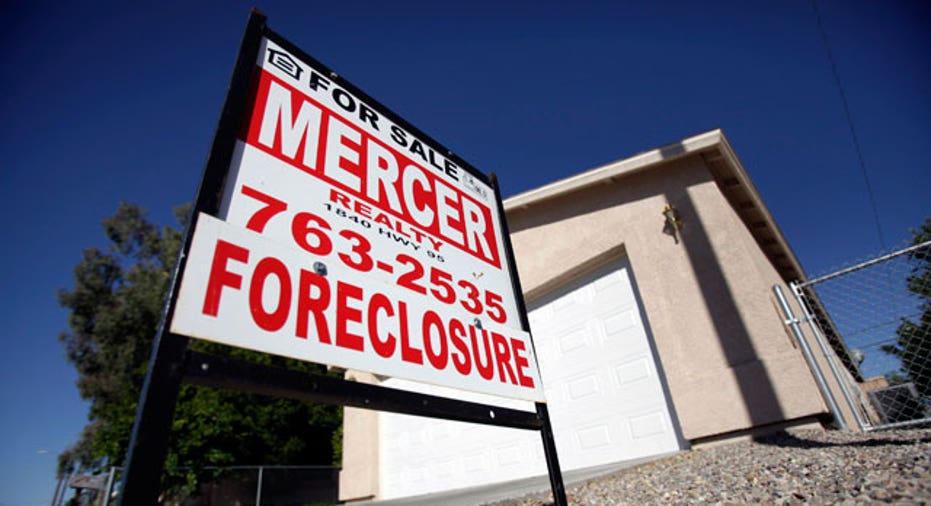Pols Seek Quick Fix Via Foreclosure Deal, Refinancings

There’s something remarkably similar about the $25 billion ‘robosigning’ settlement reached by a handful of big mortgage lenders and the three separate government refinance programs aimed at helping struggling homeowners pay their loans.
Both efforts seem to miss a larger point: that there is no quick-fix solution to the long-running U.S. housing slump. And, because of that, neither pursuit is expected to have much of an impact.
The settlement approved by the five biggest mortgage lenders – Bank of America (NYSE:BAC), JPMorgan Chase (NYSE:JPM), Wells Fargo (NYSE:WFC), Citigroup (NYSE:C), and Ally Financial – seems based on the premise that many thousands of Americans were wrongly thrown out of their homes as a result of shady foreclosure practices.
That premise is false.
What’s more, the settlement suggests that by providing financial reparations to victims of these supposedly shady practices grievous wrongs will be righted and the housing market – specifically the mortgage lending process – will somehow operate more efficiently in the future.
That premise is also false.
“There’s no economic purpose to this settlement. It’s not going to undo the damage done by people defaulting.”
Equally false is the notion that federally supervised mass refinancings are somehow a panacea for a housing market in which one in four U.S. homeowners is underwater, meaning they owe more on their mortgage than their home is worth.
A refinanced mortgage that adds $150 or $200 a month to a household’s income offers scant help to someone who has lost their job and seen the value of their home – many people’s retirement nest egg – collapse by half or more since the housing bubble burst in 2007.
President Obama last week announced his administration’s third effort at helping struggling homeowners reduce their mortgage burdens through refinancing. Two earlier programs haven’t reached a fraction of the people for whom they were intended.
Now, after more than a year of negotiations, attorneys general from 49 states have signed off on a $25 billion deal with banks accused of carelessly, and in some cases fraudulently, processing foreclosure papers.
According to terms that have leaked out in published reports, the $25 billion would be distributed as follows: $17 billion would go directly toward loan modifications, potentially reducing many thousands of mortgage principals; $3 billion would allow thousands more to refinance their loans at 5.25%; another $5 billion in cash would be earmarked for various state and federal mortgage assistance programs.
Included in that last pot are an estimated 750,000 checks valued at $1,800 each that will be sent to borrowers deemed victims of fraudulent foreclosure practices and who lost their homes between 2008 and 2011.
Critics of the settlement argue it’s steeped in politics.
“It’s been a witch hunt from the start. This has been driven by politicians and a desire for blatant retaliation or revenge against the banks,” said Anthony B. Sanders, a finance professor at George Mason University.
“There’s no economic purpose to this settlement,” he added. “It’s not going to undo the damage done by people defaulting.”
In fact, there’s broad sentiment that the investigation and its lengthy negotiations could prolong the housing slump by delaying millions of unfortunate but necessary foreclosures.
Record numbers of Americans -- 3.2 million in all, according to research firm CoreLogic -- have foreclosed on their homes since September 2008. The numbers tailed off in 2011 as investigations into improper foreclosure practices picked up. But filings are widely expected to rise again once the settlement is completed. Dumping that backlog of homes into an already saturated market will only further depress prices.
Moreover, the allegations of fraud were controversial from the beginning. Mortgage processors were inundated with foreclosure paperwork after the housing bubble burst and home values began to plummet. Many borrowers who couldn’t pay their loans but wanted to stay in their homes hired lawyers to fight or delay the process.
Those lawyers, especially ones in hard hit areas such as Florida and Arizona, discovered widespread procedural errors, much of it taking place in so-called foreclosure mills and perpetrated by ‘robosigners,’ or employees who basically rubber-stamped the paperwork as it flowed across their desks.
But the question of whether what the robosigners did constituted actual fraud or whether it was just sloppy has never been adequately answered. Besides, the vast majority of homes placed in foreclosure by banks wound up there because the borrowers were no longer paying their mortgages.
So it’s difficult to determine how robosigning hurt borrowers who had stopped paying their loans because they could no longer afford their mortgages for whatever reasons. They would have had to leave their homes at some point regardless of badly processed paperwork.
“Do we owe money to people asked to leave premises they weren’t paying for?” asked Sanders. “And is $1,800 going to get that house back?”
Robosigning, he said, is “admittedly not a good practice -- signing documents you haven’t read -- but no one was harmed.”
To many, the intervention by the attorneys general and the federal government seems a frightening replay of the perhaps well-intentioned but ultimately misguided policies that led to the dangerous run-up in housing prices a decade ago. Policies that led to ‘no doc’ and ‘NINA’ (no income no asset) loans approved to borrowers who had no business getting mortgages in the first place.
Most unsettling to critics of both the foreclosure settlement and government programs aimed at restructuring home loans is the fear that by artificially propping up housing prices these efforts are prolonging the downturn rather than easing it. Home values won’t find a natural bottom as long as the government continues to intervene, and prices won’t move higher until they reach that bottom.
“They should let the housing market heal on it’s own,” said Sanders. “This is like a wound that they keep tearing the bandage off.”